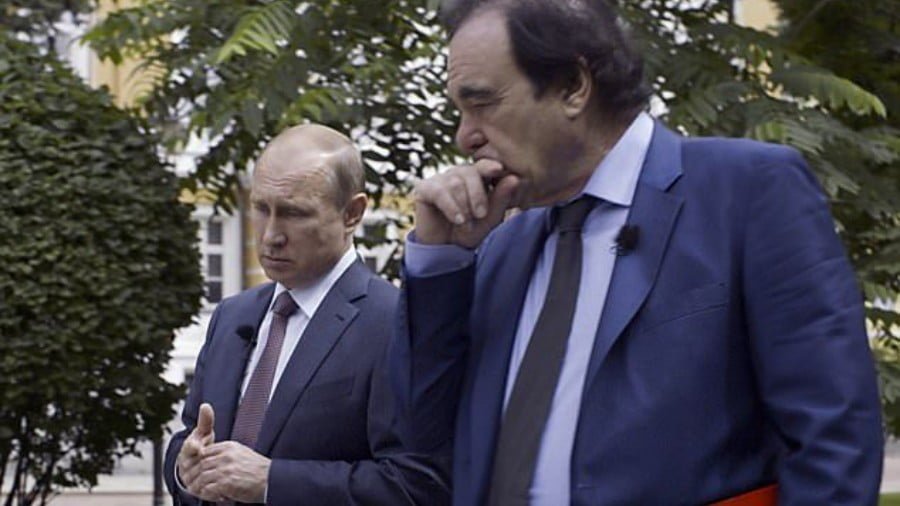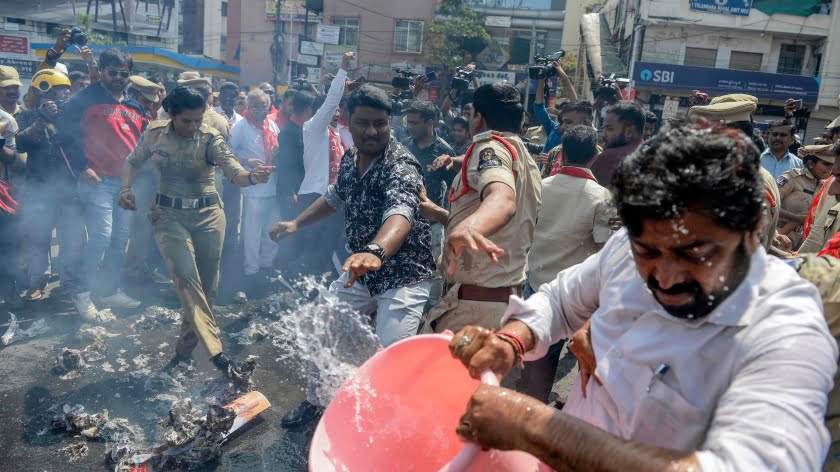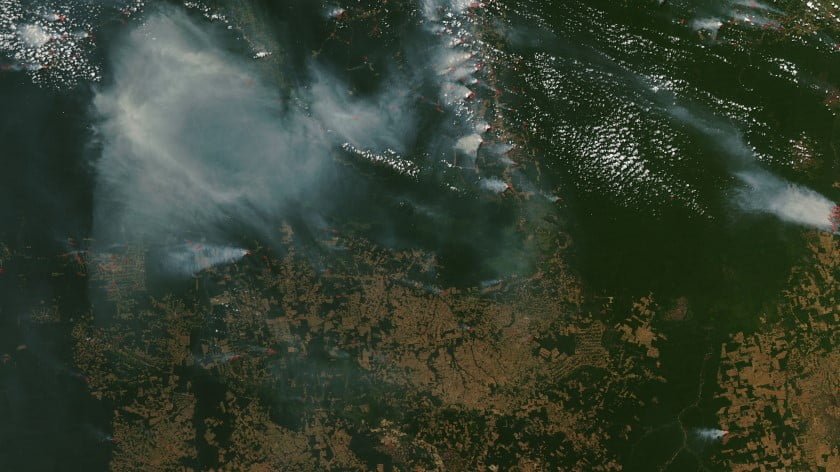Proving Putin Prescient: “Presidents Change, Policy Doesn’t” as Navalny Protests Pale
New U.S. President, same bad foreign policy. Joe Biden hasn’t been in office a week and we’re already watching an escalation of internal unrest in Russia.
Over the weekend the western press was breathless with reports of Russia cracking down on protestors across multiple cities rising up in support of jailed ‘dissident’ Alexei Navalny.
Now, let’s not play games here. Navalny is a Western asset, he’s not a significant political figure in Russia. He commands almost no electoral power in Russia. His Russia of the Future doesn’t exist outside of Moscow.
And the sole reason any of us know his name, as “The Man Vladimir Putin Fears the Most” is because of the intense Western campaign to make him relevant through the press of CIA House Organs like the Washington Post and the Wall Street Journal.
FYI, that article, linked above, is no longer on the WSJ’s website (that’s a web archive link).
Navalny has been used by Western powers to spin up trouble for Putin whenever there’s an important vote coming up in Russian politics.
Last year Navalny proved his lack of worth by being unable to materially affect the referendum on the sweeping changes to the Russian Constitution. Those changes, long overdue, devolved power out of the hands of the Presidency and handed some of it, properly, for the first time to the legislature while strengthening the judiciary.
The biggest change was banning those with dual-citizenship and those native-born Russians who haven’t spent the last 25 years in Russia from holding office.
It was Navalny’s job, after nearly ten years of grooming him to be the face of Putin’s opposition, to stop this.
And he failed spectacularly. The changes passed with overwhelming support.
The protests from this weekend yet another lame attempt at building Navalny into something relevant. After a massive PR campaign built around his supposed poisoning and his ‘brave’ return to Russia to continue his holy crusade against the demon Putin, the U.S. coordinated obvious protests around the country to create the illusion of unrest in Russia.
And all you’ll hear about is the some 4,000 arrests and “thousands of protestors” and tight shots of the crowds in Vladivostok.
But you won’t get any hard numbers because they are pathetic.
Here’s NPR (a U.S. foreign policy organ if there ever was one):
Tens of thousands of Russians took to the streets in protest on Saturday to demand the release of jailed opposition leader Alexei Navalny, braving the threat of mass arrests in what were some of the largest demonstrations against the Kremlin in years.
From the port city of Vladivostok in the east to the capital of Moscow seven time zones away in the west, protesters swept across the country in open defiance of warnings from Russian authorities that the demonstrations have been deemed illegal.
The rest of the article is nothing but quotes from the U.S. State Department, various Beltway ‘experts’ on what’s going on in Russia and human interest nonsense.
This is bad agitprop even for NPR. It’s like the West isn’t even trying anymore. But, the sad truth is, our hapless intelligence agencies are.
Navalny’s poisoning was all just a set up for building a new campaign around him because the U.S. and Europe have nothing else to throw at Russia other than missiles.
Putin’s anti-NGO Law and crackdowns on foreign media have been effective in shutting down intelligence operations from abroad and it’s clear from this latest series of incidents Putin and Russia have zero fear of it.
You can see the steps of this operation quite clearly.
- Put in place the massive vote fraud system to ensure Trump will lose in November.
- This ensures that post-election the destabilization ploys against Russia can continue into 2021.
- Create another “Putin is a Monster” story in the West by recycling the Skripal poisoning, giving it credence through repetition.
- Navalny is the only real operative of any note we have left.
- He’s flown to Germany, violating his terms of release, where Merkel uses him for a massive psy-op all summer to build the narrative at home.
- Navalny survives the deadly Novichok because he’s no good dead and bravely returns to Russia.
- This sets up the ‘No-Win’ situation for Putin. Arrest him and look like a tyrant, ensuring there will be protests. Allow him to roam free and he gains stature as the man who stood up to the Tyrant.
- Organize protests without getting ‘authorization’ in order to force a confrontation between the police and the people.
- Time that with Navalny’s ‘expose’ on the old story of Putin’s billion-dollar palace.
- Report on it as if Putin’s opposition has credibility.
But the success of this depends on there being a massive groundswell in support of Navalny.
Oops.
“Tens of thousands” in dozens of cities is pathetic. I mean, in the U.S. George Soros can get a quarter-million to D.C. for pretty much any reason on any given Saturday. In Moscow, a city of 11.5 million people in 2010 before it was expanded, that number is, at most 10,000.
Please do some math before calling me a Putin shill.
Look, the reality is that, as Putin said, if he wanted Navalny dead Navalny would be dead. To give you an idea of how inconsequential Navalny is in Russia, TASS doesn’t even afford him the respect of ‘party leader’ or ‘former candidate for Mayor of Moscow.
No, TASS calls him ‘a blogger.’ *snort*
So, Putin allowed the U.S./EU/UK to do their thing and it gave him the opportunity to find out who the ringleaders are and get rid of them as well.
The reason Navalny is an issue is because later this year it will be the Parliamentary Elections in Russia where the eighth Duma will be voted on by the people.
This is pure groundwork for election interference come this fall.
The current Duma is dominated by Putin’s former party United Russia, who got 77% in the last election and led by former President/Prime Minister and current Chair of the very important Security Council Dmitri Medvedev.
And it will likely dominate again, though likely not to the extent that it does now. Russia is, effectively, a one-party system at this point, but it’s a one-party system with the consent of the people…
… unlike the U.S.
If that wasn’t the case, the underlying dissatisfaction with Putin and United Russia, would have been far more successful. The protests that were ginned up in Belarus last summer in Minsk are an example of what can be achieved when the people don’t much like their government.
President Lukashenko got the message loud and clear and stopped pussyfooting around with the U.S. and the EU. The upshot of his successfully fending off the color revolution against him was his moving more firmly back into Russia’s orbit.
What happened this weekend was the opposite of that.
With Biden now at the helm *sic* in the U.S. the provocations against Russia will amplify. Obama is calling the shots behind the scenes and the World Economic Forum is pulling his strings.
Putin outplayed Obama along multiple fronts in 2013-16, beginning with his successful de-escalating the run up to an international war on Syria over a chemical weapons attack blamed on President Assad but never proven.
The only good thing to come out of the Biden administration in its first week in office is a pledge to extend the existing START Treaty for five years. But, I’m sure that offer only comes with Putin abandoning Nordstream 2 or ‘giving back Crimea.’
Both of those are non-STARTers, all puns intended.
Biden is a placeholder president and Russia is on the cusp of becoming a powerful engine of economic growth and destination for foreign capital. The latest numbers for 2020 just came out and, surprise to no one, China led the world in 2020 while nearly every other major economy saw capital inflows fall dramatically, including the U.S.
But as I’ve noted many times, capital inflows, especially now that things are in such flux, are a function first in the political stability of the country. So, undermining Russia politically is important in the strategy of keeping capital confused as to where it should go.
This is why it is so important that Operation Navalny was such a complete bust. It paves the way later this year for Russian elections which should underscore the relative political stability there.
What’s most important about all of this is that even though the president has changed, nothing about the policies towards Russia, or, in fact, anything important ever changes.
The election of Trump prompted the passage of CAATSA which took foreign policy out of the hands of the President through targeted sanctions. Relations with Russia under Trump were arguably worse than they were under Obama. This is a perfect example of what Putin states with regularity.
“Presidents change, policy doesn’t,” he told Oliver Stone in The Putin Interviews. Of course, he would know, since he’s now dealing with his fourth since taking over for Boris Yeltsin in 2000.
Operation Navalny is just another in a long line of moves
Now that Biden the Fungus is sporifying in the Oval Office signing whatever’s put in front of him, absolutely expect zero change in direction of U.S. policy towards Russia.
In fact, expect things to get even worse from here. If The Davos Crowd gets their way their control over the U.S. military should scare you to no end.
The only silver lining in all of this is that Biden is so guilty in Ukraine and Putin has all the goods on him, that it may wind up being the best leverage he has in keeping things from getting out of hand.
Wouldn’t that be the ultimate irony, a corrupt Joe Biden actually being more Putin’s puppet than anything Hillary could gin up about Trump?
In fact, that would be hilarious.







